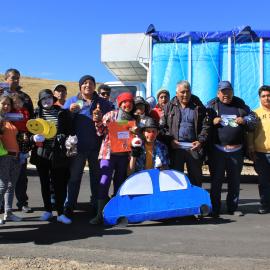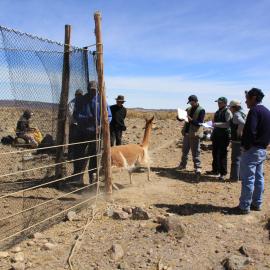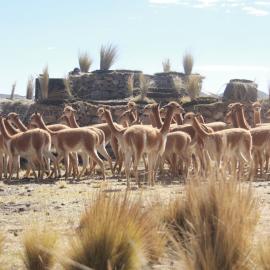Participation of the Lucanas community in the sustainable use of vicuña fibre
Current initiative
Published
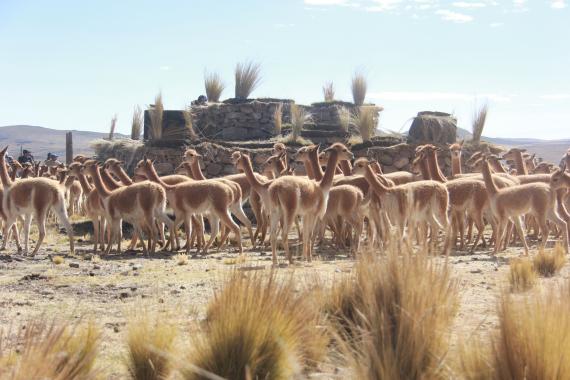
Vicuñas being penned for subsequent shearing. Credit: SERNANP – Reserva Nacional Pampa Galeras Bárbara D’Achille
The Lucanas Community, located in the south of the Ayacucho region of Peru, has played a pioneering role in the sustainable management of vicuña populations, once threatened with extinction due to poaching. Vicuña fibre is now the chief source of livelihood for the members of the Lucanas Community, and a crucial element in their socioeconomic development.
Lead
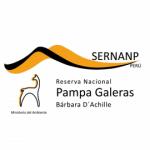
Location
The Pampa Galeras Bárbara D’Achille National Reserve (RNPGBD), in department of Ayacucho and province of Lucanas. The reserve is around 6,500 hectares and the main ecosystem comprises High Andean grasslands.
The poaching and wildlife trade problem
Species affected Vicuña Vicugna vicugna
Products in tradeFibre from the fleece of the vicuña
Overview of the problem
By the 1960s, Peru's vicuña population had shrunk to between five and ten thousand individuals due to extensive poaching. Not only was the vicuña hunted for its valuable fibre, but it was also displaced by competition for land for livestock. This brought the species to the brink of extinction.
Following government's decision to authorise the use of vicuña fibre by rural residents, local communities grew interested in conserving the species, particularly since it provided a way of ensuring income. Although there is now no evidence of poaching within the reserve, it persists in unprotected areas within the department of Ayacucho by outsiders of the Lucanas community.
The anti-IWT initiative
In order to manage the sustainable use of vicuña fibre, a plan was authorised and approved by the reserve’s Board of Directors. Under a contract signed as part of the plan, both the communities and directors must respect certain rules and meet certain requirements governing the sustainable management of the vicuña. One commitment is that the community must carry out monthly surveillance and monitoring activities in order to combat poaching.
Members of the community are involved as park rangers, with capacity-building and awareness-raising activities implemented. These focus on making the communities fully aware of the punishments for wildlife offences. Environmental education and community activities are carried out to raise local awareness of the importance of the vicuña to the lives of local people.
Community members capture and shear vicuñas in return for a daily wage. A rotation system ensures that all community members have access to this work and the fibre is traded in national and international markets. Alongside this, local communities are also working to develop tourism, with a view to ensuring a further source of income in addition to conservation activities.
The strategy
Strengthening disincentives for illegal behaviour
Increasing incentives for wildlife stewardship
Decreasing the costs of living with wildlife
Sustainable use of vicuña fibre involves land zoning - setting aside separate land for wildlife grazing as distinct from domestic livestock grazing. Farmers failing to observe zoning rules are fined. The improvement of grazing areas has led to a better quality of life for the vicuñas.
Increasing livelihoods that are not related to wildlife
The income generated by the community is spent on infrastructure and equipment, health (through the Lucanas heath centre) and education (schools in Lucanas itself and in outlying areas) with a view to improving the quality of life of local people.
Build/and or support sense of community ownership or stewardship
Improving education and awareness
Has the initiative made a difference?
Poaching has been eradicated in the reserve and the economic needs of the local population have been met. An official market has been established for legally harvested vicuña fibre, with increased income benefitting over 200 families. This has been invested in infrastructure, health, education and safety for both people and wildlife.
A regulatory framework is now in place favouring the sustainable management of natural wildlife resources, both within and outside natural protected areas.
Factors for success
Transparent and accountable distribution of benefits to local communities
Clear and tangible benefits to local communities from wildlife (These may be financial and/or non-financial)
What doesn’t work and why
It is difficult to improve environmental quality standards without resulting in increased fibre costs. Another challenge is to reduce the stress caused to wild vicuñas.
Organisers, donors and partners
Lucanas Rural Community, National Service for State-Protected Natural Areas (SERNANP)
For further information contact Aldo Espinoza Rojas (comunidadcampesinadelucanas@gmail.com).

